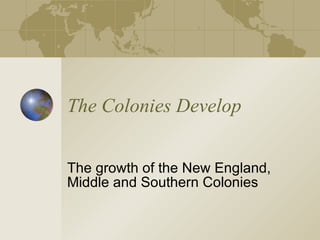
The Colonies Develop
- 1. The Colonies Develop The growth of the New England, Middle and Southern Colonies
- 2. New England The New England region included the colonies of Massachusetts, Rhode Island, Connecticut and New Hampshire
- 4. Farming in New England In New England, farming was tough. The region endured long, cold winters and the soil was rocky, making it hard to grow crops. Because of this, most people practiced subsistence farming. That is they produced just enough food for themselves and sometimes a little extra for trade in town
- 5. Fish and Lumber Although the soil in New England did not produce many crops, the forests and the sea provided useful resources and ways to make a living New Englanders built their economy on small farms, lumbering, fishing, ship building and trade
- 7. Triangular Trade The triangular trade is the name given to a trading route with three stops. This trade helped bring slavery to America and earn New England huge profits. For example, a ship might leave New England with a cargo of rum and iron. In Africa the captain would trade his cargo for slaves. Slaves then endured the horrible Middle Passage to the West Indies, where they were exchanged for sugar and molasses. Traders then took the sugar and molasses back to New England to make the rum that will start the whole process over again.
- 8. Slavery in New England Although the region was heavily involved in the slave trade, there were few slaves in New England. Because of the small farms and long winters, slavery was simply not economical for the region. Even so, some New Englanders in larger towns and cities did own slaves. These slaves worked mainly as house servants and cooks.
- 9. The Middle Colonies The four Middle Colonies were New York, New Jersey, Pennsylvania and Delaware.
- 10. An Area Rich in Resources The Middle Colonies boasted a longer growing season than New England and a soil rich enough to grow cash crops. Cash crops were crops made to be sold for money. Common cash crops included fruits, vegetables, and, above all, grain. The Middle Colonies grew so much grain that people began calling them the “breadbasket” colonies.
- 11. Big Cities in the Middle Colonies The excellent harbors along the coasts of the Middle Colonies were ideal sites for cities. The merchants who lived in these growing port cities exported cash crops, especially grain, and imported manufactured goods. Because of its enormous trade, Philadelphia was the fastest growing city in the colonies. New York could also thank trade for its rapid growth.
- 12. A Diverse Region The people who settled the Middle Colonies represented many cultures and religions. One important group, the Quakers, started the colony of Pennsylvania. Others seeking religious freedom soon followed. Settlements of French, Dutch, German, Swedes, Danes, Finns, Scots, Irish and English spread throughout the Middle Colonies
- 13. A Climate of Tolerance While the English Puritans dominated life in the New England colonies, many different groups contributed to the culture of the Middle Colonies Because of the great number of different groups, no single group could dominate the others. Thus, the region’s diversity helped create a climate of tolerance. Some of the region’s religious groups, such as the Quakers in Pennsylvania, also helped promote tolerance and equality.
- 14. Slavery in the Middle Colonies The tolerant attitude of many settlers in the Middle Colonies did not prevent slavery in the region. In 1750, about 7% of the Middle Colonies’ population was enslaved.
- 15. The Southern Colonies The five Southern Colonies were Maryland, Virginia, North Carolina, South Carolina and Georgia.
- 16. The Plantation Economy The South’s soil and almost year-around growing season were ideal for plantation crops like rice and tobacco These valuable plants required much labor to produce, but with enough workers they could be grown as cash crops Planters had no trouble transporting their crops because of the region’s many rivers and waterways.
- 17. Lack of Cities in the South Most plantations were self-sufficient. That is, nearly everything the planters, their families and their workers needed was produced on the plantation Because plantations were so self-sufficient, large cities like those in the North were rare in the Southern Colonies.
- 18. The Turn to Slavery As the plantation economy continued to grow, planters began having difficulty finding enough laborers to work their plantations. At first, they turned to European indentured servants to work the fields. However, this did not last for long. With large amounts of cheap land available in America, it was easy for white men to save enough money to buy land and start their own farms.
- 19. The Turn to Slavery Planters then tried to force American Indians to work for them, but European diseases caused many of the Indians to die. Those who survived usually knew the land well enough to run away. To meet their labor needs, the planters finally turned to enslaved Africans. As a result, the population of people of African descent began to grow. By 1750, there were 235,000 enslaved Africans in America.